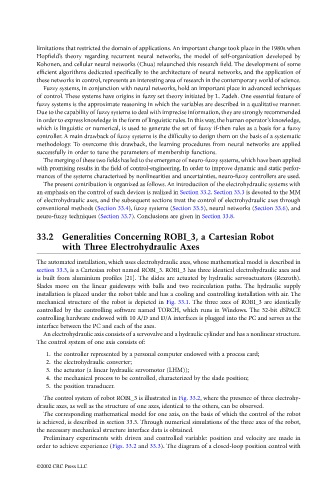Page 978 - The Mechatronics Handbook
P. 978
limitations that restricted the domain of applications. An important change took place in the 1980s when
Hopfield’s theory regarding recurrent neural networks, the model of self-organization developed by
Kohonen, and cellular neural networks (Chua) relaunched this research field. The development of some
efficient algorithms dedicated specifically to the architecture of neural networks, and the application of
these networks in control, represents an interesting area of research in the contemporary world of science.
Fuzzy systems, in conjunction with neural networks, hold an important place in advanced techniques
of control. These systems have origins in fuzzy set theory initiated by L. Zadeh. One essential feature of
fuzzy systems is the approximate reasoning in which the variables are described in a qualitative manner.
Due to the capability of fuzzy systems to deal with imprecise information, they are strongly recommended
in order to express knowledge in the form of linguistic rules. In this way, the human operator’s knowledge,
which is linguistic or numerical, is used to generate the set of fuzzy if-then rules as a basis for a fuzzy
controller. A main drawback of fuzzy systems is the difficulty to design them on the basis of a systematic
methodology. To overcome this drawback, the learning procedures from neural networks are applied
successfully in order to tune the parameters of membership functions.
The merging of these two fields has led to the emergence of neuro-fuzzy systems, which have been applied
with promising results in the field of control-engineering. In order to improve dynamic and static perfor-
mances of the systems characterized by nonlinearities and uncertainties, neuro-fuzzy controllers are used.
The present contribution is organized as follows. An introduction of the electrohydraulic systems with
an emphasis on the control of such devices is realized in Section 33.2. Section 33.3 is devoted to the MM
of electrohydraulic axes, and the subsequent sections treat the control of electrohydraulic axes through
conventional methods (Section 33.4), fuzzy systems (Section 33.5), neural networks (Section 33.6), and
neuro-fuzzy techniques (Section 33.7). Conclusions are given in Section 33.8.
33.2 Generalities Concerning ROBI_3, a Cartesian Robot
with Three Electrohydraulic Axes
The automated installation, which uses electrohydraulic axes, whose mathematical model is described in
section 33.3, is a Cartesian robot named ROBI_3. ROBI_3 has three identical electrohydraulic axes and
is built from aluminium profiles [21]. The slides are actuated by hydraulic servoactuators (Rexroth).
Slades move on the linear guideways with balls and two recirculation paths. The hydraulic supply
installation is placed under the robot table and has a cooling and controlling installation with air. The
mechanical structure of the robot is depicted in Fig. 33.1. The three axes of ROBI_3 are identically
controlled by the controlling software named TORCH, which runs in Windows. The 32-bit dSPACE
controlling hardware endowed with 10 A/D and D/A interfaces is plugged into the PC and serves as the
interface between the PC and each of the axes.
An electrohydraulic axis consists of a servovalve and a hydraulic cylinder and has a nonlinear structure.
The control system of one axis consists of:
1. the controller represented by a personal computer endowed with a process card;
2. the electrohydraulic converter;
3. the actuator (a linear hydraulic servomotor (LHM));
4. the mechanical process to be controlled, characterized by the slade position;
5. the position transducer.
The control system of robot ROBI_3 is illustrated in Fig. 33.2, where the presence of three electrohy-
draulic axes, as well as the structure of one axes, identical to the others, can be observed.
The corresponding mathematical model for one axis, on the basis of which the control of the robot
is achieved, is described in section 33.3. Through numerical simulations of the three axes of the robot,
the necessary mechanical structure interface data is obtained.
Preliminary experiments with driven and controlled variable: position and velocity are made in
order to achieve experience (Figs. 33.2 and 33.3). The diagram of a closed-loop position control with
©2002 CRC Press LLC

